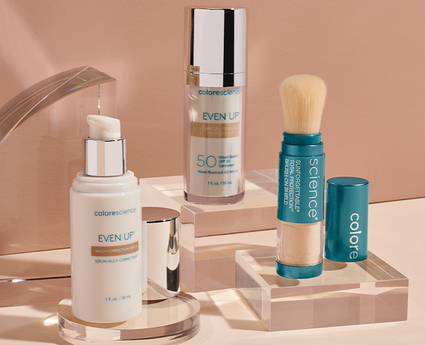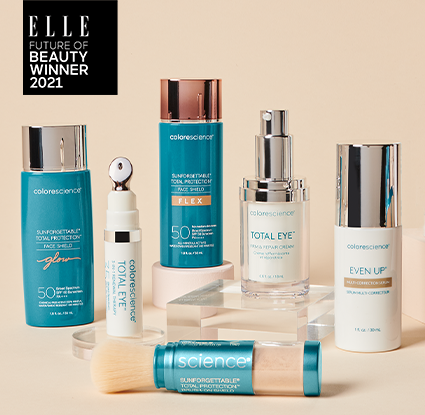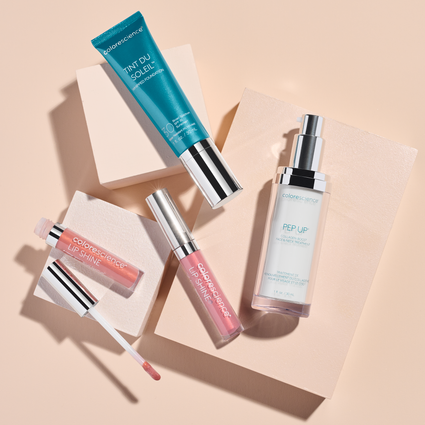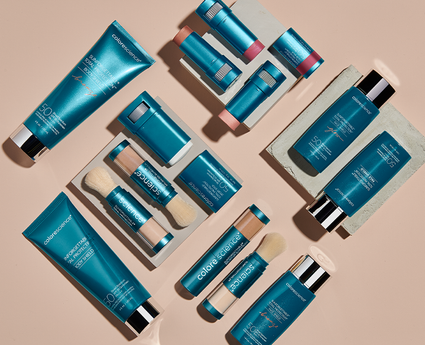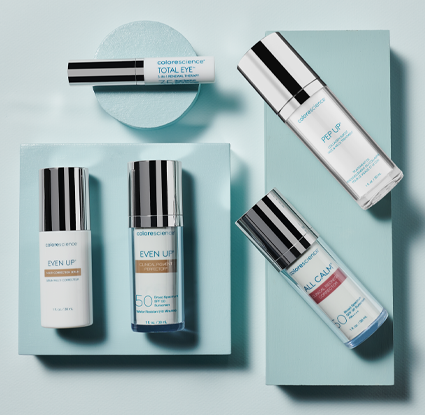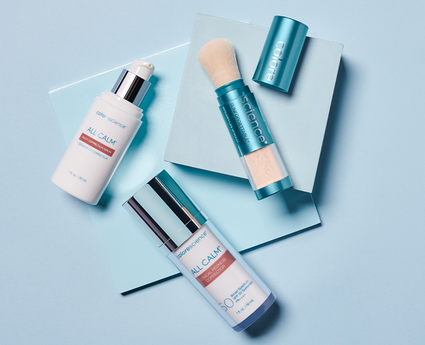How to Use Bronzing Primer to Get Glowing Skin
Everyone wants the radiant glow of a perfectly sun-kissed complexion. Unfortunately, few of us are naturally endowed with such a gorgeous bronze tone. During warmer weather months, many of us flock outdoors in the hopes of soaking up some of that glorious vitamin D to get a tan and a little color. This endeavor comes at a cost: wrinkles, sunspots, premature aging, and even the risk of cancer.
In the winter months, as the skin’s melanin production slows and our color fades, we turn to products to help restore that glowing golden-brown. While this method is safer and certainly faster than catching rays outside, it also comes with a tradeoff. If you use the wrong bronzer, or apply it incorrectly, you run the risk of looking orange, cakey, or artificial – the opposite of that natural-looking glow you seek.
If you’re wondering how to get glowing skin using bronzing primer, powder, and other perfecting products, we’re here to help.
First, we’ll give you a cheat sheet that breaks down how to find the ideal bronzer to add to your makeup arsenal. Next, we’ll teach you step by step how to achieve the perfect bronzer application, including your very own bronzing cheat sheet. Finally, we’ll stress the big bronzer no-no’s so you can feel confident in your luminous complexion.
Glowing skin is just a few paragraphs away—let’s get started.
What is Bronzer Used For?
Bronzers are a type of powder or liquid cosmetic that can be used to warm the complexion, add dimension to the face, and achieve a healthier appearance.
Contrary to popular belief, bronzers are not intended to fake a tan or create a contour; alternatively, they are used to mimic where the sun hits your face naturally and add shape to an otherwise flat foundation.
What’s the difference between faking a tan and emulating sun-kissed skin?
When you fake a tan, you’re trying to obtain the color you think your skin would be if you were to tan naturally. Anyone who’s held a dark brown bronzer in their hand knows this tone is nowhere near shades of natural tan. However, when blended properly and applied in the correct spots, the right bronzer can make you appear as though you spent a wonderful day outdoors – not 15 minutes in a spray tan booth.
Furthermore, if bronzer was used to “fake a tan,” it’d require the product to be applied all over the face, which is definitely not the way to go (don’t worry, we’ll teach you how to apply bronzer – the right way – in due time). If you attempted to fake a facial tan with a bronzer, you’d disconnect your complexion color with the rest of your body. This just looks plain weird – especially when your pasty white hands are juxtaposed against an orange face.
What’s the difference between contouring and shaping?
Contouring is a makeup application strategy where deeper and lighter shades are applied to specific areas of the face; this is done to shade and define certain features, such as the nose, forehead, chin, and cheeks. It calls for the use of matte powders, creams, or pencils that are roughly two shades darker than one’s actual skin tone in order to reshape the face, creating higher cheekbones, slimmer noses, and sleeker jawlines.
Contouring used to be a secret weapon reserved by beauty gurus unveiled at photoshoots; now, contouring has infiltrated the social media and YouTube scene, inspiring ordinary enthusiasts to give it a go – with more or less success. When contouring is done wrong (ahem, say, with a bronzer) it can look disastrous. Contouring creates shadows, taking away light to lend a hollowed appearance.
Too much, and you can look gaunt or as though you were knocking on death’s door. Alternatively, bronzers are used to shape the face and break up the monotony of a plain foundation. It adds dimension by framing the face, bringing its various features to the center. The eyes, nose, cheeks, and lips become the center of attention. It adds a healthy dose of color to the complexion, making the face appear vivacious and radiant.
Finding the Right Bronzer
As with most cosmetic products in the booming beauty world, the amount of bronzer choices is dizzying. There are so many formulas, textures, finishes, shades and intended uses that making the right decision when choosing a product can seem like an impossible feat. Here we’ll give you a cheat sheet for the various bronzers available on the market, and which one is best recommended for your skin type and tone.

Different Types of Bronzer Formulas
- Bronzing Primer: Like all primers, a bronzing primer is usually a gel that’s applied before makeup with the intention of buffering out imperfections, filling in fine lines, and setting the skin in preparation of foundation for longer-lasting wear. A bronzing primer, however, will be slightly tinted to provide a sheer veil of glimmer while offering a smooth complexion. It most likely will come in a lightweight formula that allows you to layer a universal bronze shade for buildable luminosity. Some bronzing primers will even contain SPF protection, such as the Colorescience Bronzing Perfector 3-in-1 Face Primer SPF 20.
- Cream Bronzer: Creamy bronzers don’t contain much shimmer, but due to their moist consistency, deliver a sheen quality by nature. Whereas powders can make your skin appear dusty, the sheerness of cream bronzers allow you to still see the texture of your skin beneath the product, making you look healthy, dewy and glowing. They’re easy to blend, either with your fingers or a blending brush, but be sure your skin is hydrated. Otherwise, the cream won’t have a smooth surface to glide over, and you’ll end up with streaks no matter how careful you are. Oh, and never wear cream bronzer over powder foundation – it defies the science of makeup.
- Powder Bronzer: Most people envision a compact powder when they hear the term “bronzer”. Powder bronzer is not only popular due to its iconicity, but for the natural finish it offers. Powder tends to produce a velvety feel and has a mattifying effect on the skin. It has more longevity than its cream-based counterpart, but it can be a bit more difficult to blend. Without light application and proper blending, powder bronzer runs the risk of muddying your makeup look.
- Liquid Bronzer: Bronzer aficionados love the lit-from-within look liquid formulas provide. They’re versatile, and can even be used as an eyeshadow. Their fluidity creates more of a real-skin radiance that can be hard to come by in powders or creams, but believable bronzer comes at a cost. Liquid formulas tend to be much darker in shade, which demands very precise blending. Unless you’re a beauty pro, liquid bronzers can be a bit intimidating.
Bronzers Based on Skin Type
If you’re having a hard time deciding which formula you fancy most, keep your skin type in mind. As with all variations of face makeup, the type of skin you have could greatly impact which product you should use. Here are the best bronzers to use, according to skin type:
- Dry/mature skin: Powder can emphasize dryness and wrinkles, so you might prefer liquid bronzers instead. Their moist formulas deliver a hydrated glow and are great for dry, damaged, or mature skin.
- Normal skin: If you have a normal skin type, and infrequently experience breakouts, chances are you can use any kind of bronzer. Make your choice based on personal preference.
- Oily skin: People with oily skin often struggle with excessive shine, and would benefit best from a powder bronzer. The powder will absorb the oil and the matte finish will help correct shininess. If you have large pores or acne scars, avoid shimmery bronzers as they can emphasize uneven skin texture. Instead choose a priming bronzer for a sun-kissed tint that buffs out imperfections.
Different Bronzer Finishes
Picking a bronzer doesn’t stop at choosing the formula that works best for you. There are several different finishes of bronzer, and each one can have a different effect on your final look:
- Shimmer bronzer: These bronzers contain light-reflecting particles to highlight the skin, making your complexion glow and enhancing your best features. Restrict this application to cheekbones and temples because it’s very easy to go overboard if used liberally.
- Matte bronzer: A matte bronzer has no shimmer or sheen, and is intended to warm up the skin. Matte bronzers thereby add depth to the complexion and give a natural skin-like finish. For added dewiness, find a cream bronzer in a matte finish.
- Sheer bronzer: Although sheer bronzers are subtle, they still come with benefits. They provide an all-over, sun-kissed glow while still maintaining a natural-looking finish. Sheer products are much easier to work with than other bronzers, as they are least likely to become too muddy, orange, or shimmery.
How to Find the Perfect Shade

The trickiest part of choosing a bronzer is finding a shade to match your skin tone; picking the wrong one is the surest way to turn you cringe-worthy orange. Generally speaking, you’ll want to find a bronzer similar in tone to the color of your arms and chest. Look at your face, and go roughly two shades darker, but be sure to start with your skin’s undertones:
- Bronzers for cool undertones: For skin with cooler, pinker, or beige-based undertones, opt for a peachy or cool-toned bronzer with a taupe finish.
- Bronzers for neutral undertones: Most bronzers will look great on those with neutral undertones – even a little bit of red in the product won’t hurt.
- Bronzers for warm undertones: If you have warm-toned skin, definitely stick with golden hues, as many bronzers can look too orange otherwise.
Once you know which undertone your skin has, and which tone to look for in a bronzer, you can begin looking at different shades:
- Bronzers for fair skin tones: Go for warm shades of beige and honey to town down the natural pink tint of alabaster skin. Find a shimmer bronzer in your shade, as they work particularly well to give a believable summer glow to those with light or fair skin.
- Bronzers for medium/olive skin tones: If your skin is naturally tan, find neutral shades of amber and gold to even out the complexion and add a youthful radiance. Matte bronzers work best for medium or olive skin tones because they enhance the skin’s natural warmth without overpowering a complexion with shimmer.
- Bronzers for dark skin tones: Sheer bronzers are especially great for those with very dark skin, because they allow for added warmth without necessarily adding distinct color.
How to Get Glowing Skin with Bronzing Primer, Powder, Cream and/or Liquid Bronzer
We tried to warn you – finding the right bronzer is no simple task. Armed with your cheat sheet, you should now feel confident in your ability to pick the right product based on your skin type and tone. Keep in mind that your perfect bronzer can change seasonally, and different formulas or finishes can be used in conjunction with one another.
Find your perfect formula in your favorite finish, and follow these steps to achieve a seamless application that has people wondering what beach you just left.

- If you’re not using a bronzing primer, be sure to prime your face and apply your foundation prior to using bronzer. Once your canvas is prepared, squirt a little liquid bronzer into the palm of your hand, and use a bronzer brush to swirl the product until the color is entirely in the bristles (avoid blenders or spongers as they will apply too much product). Apply the bronzer to the areas of your face the sun would naturally hit. Pro tip: Create a figure “3” with your bronzer brush, starting from the forehead, moving outward toward the temple, then under the cheekbone, and along the jawline.
- Add definition to your face using a contouring cream, stick, or powder. Start from the middle of your ear and head toward the corner of your mouth, stopping mid-cheek, to pronounce your cheek hollows and elevate your cheekbones. To detract from a pronounced forehead, apply your product along your hairline and temples. Use a blender to make your contours appear natural.
- Use powder to apply a second coat of bronzer. Follow the same figure-3 shape as before, being sure to hit the spots the sun touches most: the cheeks, nose, chin, and forehead. Be sure to tap off excess powder from your brush to avoid applying too much product and turn into an unnatural color or texture. Pro tip: To make noses appear smaller or straighter, use an eye shadow brush to trace along both sides of the nose for an illusion of symmetry and slimness.
- Take your brush and lightly dust bronzer on your neck and ears. This step is critical for blending your makeup to match the rest of your complexion. Remember, we’re not trying to fake a tan here. An unnaturally dark face, set against paler surrounding skin, will appear orange and artificial.
- Double check each side of your face in the mirror to ensure your bronzer is cohesive with the rest of your makeup. This means no streaks, hard lines, or visible edges. Pro tip: whether you find visible traces or not, the best practice is to always even it out with a blender or buffing brush. What might look passable in your bathroom lighting could drastically change in natural light. Prevent this mistake by making blending an automatic part of your makeup routine.
- Unless your bronzer has a shimmer finish, use a highlighter to add a bit of sparkle. Some people are under the mistaken notion that you can either use a bronzer or highlighter, but this isn’t true. As long as you don’t excessively apply illuminators, the two products work very well in conjunction with each other and won’t make you appear overdone nor glittery. Use a highlighter or brightening product to enhance specific facial features. For example, apply it to your cupid’s bow and the center of your lips to define a more perfect pout. Or, add highlighter to the inner eye corners and brow bone to create an illusion of wider, brighter eyes. Pro tip: For the most ethereal results, be sure to understand the difference between a bronzer and highlighter. The former adds warmth and shape, while the latter adds light and attention. Knowing their different goals will help you apply them more correctly.
- Use a setting spray or a setting powder to complete your lustrous bronze look. These products act like hairspray – the finishing touch in your beauty regimen. They keep your makeup in place and help prevent makeup meltdowns. Depending on which formula you use, some may hydrate your skin, while others help keep you cool on balmy days. When you’re done applying your makeup, hold a setting spay at arm’s length and gently spritz the product over your face a few times. Don’t rub it in or pat it with a towel; just allow it to air dry naturally.
Common Bronzer Mistakes to Avoid
You’re well on your way to finding that warm, radiant glow. But before you rush to practicing a perfect application or filming a beauty tutorial, make yourself aware of the common bronzer mistakes that occur all too frequently. Even the best beauty bloggers are liable to make one of these mistakes from time to time. For a perfectly bronzed look, be sure to avoid:
- Attempting to contour: You’d need to be very lucky to find a matte bronzer that works well enough as a contour to not appear heavy or unnatural. Use a bronzer to complement your face, not disguise it. Trying too hard to make your cheeks “pop” using the wrong product will in turn make you appear jaunt and jowly.
- Loading the brush and applying it directly: Especially with respect to powder bronzer, be sure to never directly apply a freshly loaded brush to your face – chances are you’ll apply way too much product. Instead, swirl the brush in the product pot, tap off the excess, and then apply. In the case of liquids or creams, start slowly, gradually increasing the amount you apply versus loading it all on at once.
- Applying it all over your face: Unless you want to look like a character reminiscent of Willie Wonka, we can’t stress this enough. Reserve your bronzer to the places the sun touches most: the forehead, tip of the nose, along the cheekbones, and jawlines.
- Using the wrong applicator: We mentioned before that sponges and beauty blenders aren’t ideal for transferring bronzer to your face; neither are dense brushes, or any brush that results in applying way too much product. For a light and flawless application, choose a fluffy blush brush or angled bronzer brush.
- Wearing the wrong shade: This is often a lesson in trial and error, but be sure to eventually find the shade that matches your complexion. Settling for the wrong tone will just make your complexion look off—not kissed by the sun. Remember to pay attention to undertones, and never go more than two shades darker.
The list of bronzer blunders goes on and on, making this cosmetic one of the trickier products in our makeup bag. To keep it simple, we’ve narrowed down our list of the 5 biggest bronzer application don’ts in the chart below. Mistakes can always be fixed, and errors can always be corrected, so don’t put too much pressure on yourself to avoid the following no no’s:

Now you don’t have to wait until summer or risk the harmful effects of UVA and UVB rays to create a radiant bronze look. Warm up your complexion – whether it’s hot or cold outside – by following this advice for how to get glowing skin with bronzing primer, powder, or other warming product. If you play to your skin type and skin tone, you’re sure to find the perfect bronzer with a luminous finish. Make orange streaks a fear of the past and use this guide for a naturally sun-kissed appearance all year long.

